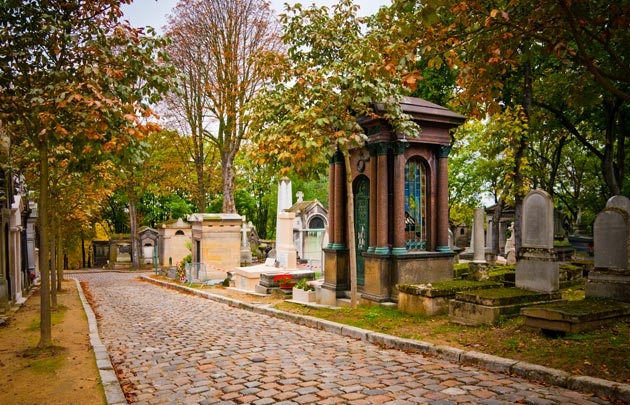The Personality of Parisian Cemeteries

When I first visited Père Lachaise as a tourist a decade ago, it was difficult to grasp why a cemetery — usually a secluded and sacred place — was a tourist attraction in Paris. The atmosphere in the city's most famous cemetery was straight out of a gothic tale by Edgar Allan Poe. The cry of ravens, the mossy tombstones, and the shadows of mausoleums created an eerily morbid ambiance that spoke to my childhood imagination. But why so many tourists?
Now a university student living in Paris, a visit to Père Lachaise is like rediscovering a familiar place with new eyes. Paris is a city examined through its art, culture, architecture, and history. And part of that history is the city's cemeteries. Especially since the tombstones of so many famous people can be found there. The graves of pop culture icons such as Édith Piaf, Maria Callas, and Jim Morrison attract fans who come on pilgrimages to Père Lachaise. So do the graves of famous artists, writers, and composers as varied as Chopin, Modigliani, and Oscar Wilde.
Chopin's grave, Père Lachaise. Image credit:perelachaisecemetery.com
The world's most visited cemetery, Père Lachaise is a place whose identity has been transformed by the global emergence of tourism in the 20th century. But it wasn't always so. Père Lachaise opened in 1804 in the east end of the French capital, taking its name from Louis XIV’s confessor and the spiritual adviser Père François de La Chaise who lived in a Jesuit house on the land where the cemetery is now located.
Established under Napoléon Bonaparte, the cemetery was designed by the prominent French architect Alexandre Theodore Brongniart. It extends over 44 hectares and contains 70,000 burial plots, including those of Balzac, Bizet, Rossini, Isadora Duncan, Pissarro, and Delacroix. The cemetery is visited by so many tourists that it's not an overstatement to say it's part public park, part burial ground.
Père Lachaise not only tells the stories of its famous "residents", it has also served as the setting for important historical events. For example, its Communards' Wall is where 147 combatants during the Paris Commune were lined up, shot, and thrown in an open trench at the foot of the wall. Ironically, Adolphe Thiers, the French president who ordered that violent repression during the "Bloody Week", is also buried in the cemetery. His tomb is often a subject to vandalism.
Père Lachaise is so famous that it's easy to forget that Paris has other, more discreet, graveyards: Passy, Montmartre, and Montparnasse.
Père Lachaise. Image credit: perelachaisecemetery.com
Passy cemetery, a peaceful enclave located in the 16th arrondissement across the Seine from the Eiffel Tower, was also created under Napoleon. Traditionally it was the cemetery where the Parisian elite were buried. While walking among the beautifully decorated tombstones under tall chestnut trees, one comes upon famous names such as Claude Debussy, Princess Brasova, and the last emperor of Vietnam Bao Dai.
Montparnasse cemetery, opened in 1824, was originally known as Le Cimetière du Sud due to its Left Bank location in south Paris. Located in the Montparnasse quarter, the cemetery is cut in two by rue Émile Richard. The smaller section is usually referred as the "petit cimetière" and the large division as the "grand cimetière". The Montparnasse cemetery includes the huge garden of sculptures and statues where a number of French poets, novelists, and intellectuals and are buried — from Charles Baudelaire and Guy de Maupassant to Susan Sontag, Jean-Paul Sartre, and Simone de Beauvoir.
Passy Cemetery. Image credit: Instagram @fotokit
Montmartre cemetery in the 18th arrondissement was opened in 1825. It's the third largest necropolis in Paris after Père Lachaise and Montparnasse. Initially known as Cemetery of the Large Quarries, the name referred to the cemetery's location in an abandoned gypsum quarry that was used as a mass grave during the French Revolution. Montmartre cemetery is the final resting place of many famous artists, such as Hector Berlioz, Stendhal, François Truffaut, Edgar Degas, Alexandre Dumas, and Émile Zola.
Today Père Lachaise has transformed itself into a tourist site where visitors experience the same feeling as going to an outdoor museum. Many bring flowers, letters, and souvenirs to the graves. They pose and take selfies, have picnics, drink French wine, even play the guitar and sing. Besides the tourists, one can often find young Parisians hanging out in the cemetery, drinking, smoking and partying. Elderly people also visit Père Lachaise to walking with their dogs along the cobblestone pathways.
Communards' Wall, Père Lachaise. Image credit: Père Lachaise cemetery
Père Lachaise is different from the other Parisian cemeteries because of its dual identity as graveyard and tourist attraction. It also has tremendous artistic appeal due to the variety of gravestone decorations and designs from different funerary art styles ranging from Gothic tombstones to Haussmannian mausoleums. Each representing a different aspect of the rich and complex history of Paris. And many keeping their secrets for eternity.
Image credit: instagram @ajhphotographie












